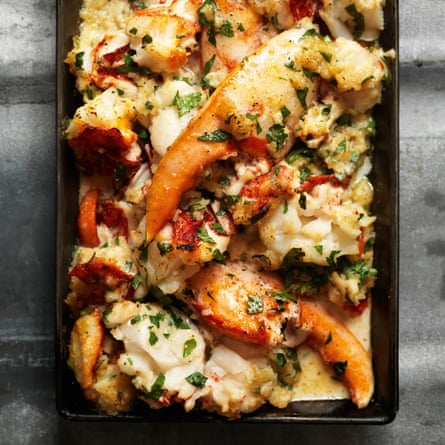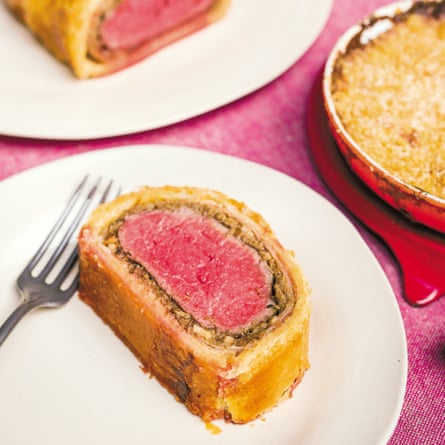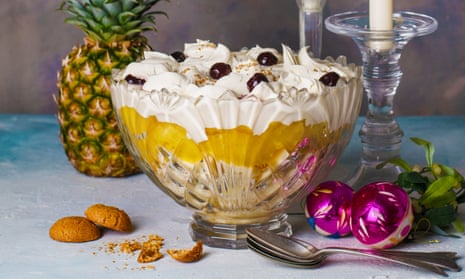Claire Ptak’s pineapple kirsch trifle
I love how exotic it is to have pineapples in the kitchen, and the holidays, when local fruit is scarce, is the perfect time to buy a few plump ones. Pineapples and kirsch have a long history together. A French bistro classic is chunks of the tropical fruit soaked in the cherry-flavoured liqueur, served simply, perhaps with a thin crisp biscuit on the side. Turning this combination into a version of the beloved British trifle makes so much sense. I grill the pineapple with a little sugar and some kirsch to the point that it almost catches and softens to a tender consistency. After that wonderfully warming meal we wait all year for, this cold, bright and boozy pudding is just the thing. Look for fruits that are fragrant and heavy with a green crown that isn’t drying out.
Makes enough for 8
For the chiffon sponge
plain flour 160g (use fine sponge flour if it’s available, but if it’s self raising, leave out the baking powder)
baking powder 1 tsp
caster sugar 150g
salt ½ tsp
vegetable oil 65g
eggs 5, separated
water 5 tbsp
vanilla extract 1 tsp
whole nutmeg a few grates
cream of tartar ¼ tsp
For the custard
double cream 480ml
milk 240ml
vanilla bean 1, scraped
caster sugar 70g
egg yolks 6
salt ¼ tsp
For the pineapple
pineapples 2 large
caster sugar 4–6 tbsp
kirsch 8 tbsp
For the cream
mascarpone 250g
double cream 480ml
For the topping
sour cherries in kirsch or Amarena cherries
amaretti biscuits 75g, crushed
First make the sponge. Preheat the oven to 150C/gas mark 3. Grease the bottom of a 20 x 30cm rectangular tin. Do not grease the sides.
Sift the flour and baking powder together in a bowl, then whisk in 50g of caster sugar and the salt. Set aside.
In another bowl, whisk together the oil, egg yolks, water, vanilla and nutmeg. Make a well in the centre of the dry ingredients and gradually add the wet to form first a paste and then a consistency much like pancake batter.
In the bowl of an electric mixer, whisk together the egg whites, the remaining 100g of caster sugar and the cream of tartar. Whisk into firm, meringue-like peaks. Stir one third of this mixture into the cake batter, then gently fold in the remainder. Pour the cake mix into the prepared tin and bake until set, golden and springy to the touch, 20-25 minutes.
Then make the custard. Heat the cream, milk, vanilla pod, sugar and salt together in a small saucepan over medium heat. Put the egg yolks into a bowl and whisk to break up. Bring the cream mixture just to the boil, then carefully pour one third of the contents over the yolks whisking to temper them. Whisk in the remaining milk and pour the contents back into the saucepan and heat over a medium heat stirring constantly so it does not catch or curdle. As soon as it thickens enough to coat the back of the spoon, remove from the heat and decant into a container that will fit in your fridge. Chill completely (about 2 hours).
Meanwhile, prepare the pineapple. Top and tail the pineapple and cut off all of the rind. Use the tip of your knife to also remove any small seeds lodged into the fruit. Cut the fruit off the core and discard the core. Slice the pineapple into 2mm slices and put into a large roasting dish. Sprinkle over the sugar and half of the kirsch. Bake at 220C/gas mark 7 for 20 minutes or until the fruit is tender and starting to turn golden on the edges. Toss if you desire and roast for another 5 minutes. Set aside to cool completely.
Put the mascarpone in a bowl and add a little cream to loosen it. Add the remaining cream and whip until quite firm. Chill.
Cut the sponge into fingers and line the trifle bowl. Drizzle with the remaining kirsch and add the cooked pineapple and any juices. Cover with custard then dollop with mascarpone cream. Dot with candied, glacé or kirsch-soaked cherries and chill. Just before serving, sprinkle with the amaretti crumbs.
Claire Ptak is chef-owner of the Violet Bakery, 47 Wilton Way, London E8 3ED
Anna Jones’s celebration celeriac and sweet garlic pie

This has been my Christmas centrepiece for the last couple of years. It’s everything I want in a pie: a cheddar and winter-herb flaky pastry; a creamy filling, sweet with balsamic garlic and roasted celeriac; and a crisp grated celeriac roof.
Serves 8-10
For the pastry
plain spelt flour 250g, plus a little extra for dusting
unsalted butter 125g, cold, cubed
fine sea salt ½ tsp
rosemary, thyme and sage a few sprigs of each, leaves picked and finely chopped
lemon zest of 1 unwaxed
good cheddar 25g, grated
egg yolk 1 medium
cold water 50–70ml
For the filling
garlic 3 heads, cloves separated and peeled
olive oil
balsamic vinegar 1 tsp
runny honey 1 tbsp
rosemary, thyme and sage 2 sprigs of each, leaves picked and finely chopped, plus extra to finish
celeriac 1kg
Lancashire or good cheddar cheese 220g, crumbled
creme fraiche 150g
lemon juice of ½
wholegrain mustard 1 tbsp
parsley a small bunch, chopped
Worcestershire sauce
eggs 2, beaten
Put the flour into a mixing bowl. Add the butter and salt. Rub gently with your fingertips until the mixture is like fine breadcrumbs. Stir through the herbs, lemon zest and cheddar.
Beat the egg yolk with 1 tablespoon of cold water. Add to the flour and mix until it forms a dough. Add more water, a teaspoon at a time, until it comes together into a smooth dough. Wrap in cling film and chill in the fridge while you make the filling.
For the filling, put the cloves of garlic into a saucepan, cover with cold water and bring to a gentle simmer. Cook for 2–3 minutes, then drain.
Wipe the saucepan dry. Add the garlic and 1 tablespoon of olive oil and fry on a high heat for 2 minutes. Add the balsamic vinegar and 100ml water, bring to the boil and simmer gently for 10 minutes.
Add the honey, most of the rosemary and thyme (reserving the rest, with the sage) and a good pinch of salt. Continue to cook on a medium heat for a further 5 minutes, or until most of the liquid has evaporated and the garlic cloves are coated in a dark syrup.
Meanwhile, peel the celeriac and cut it into quarters. Set aside 300g and slice the rest into 2cm-thick pieces. Put them into a saucepan, cover with hot water and boil for 7–10 minutes, until they are soft and have turned slightly translucent.
Drain and tip into a big mixing bowl. Add the cheese, creme fraiche, lemon juice, mustard, parsley, a splash of Worcestershire sauce and eggs. Add a good pinch of salt and grind of pepper and gently fold in the garlic cloves.
Preheat the oven to 180C/gas mark 4. Sprinkle flour on a work surface and roll out the pastry to 3–4mm thick. Line a 20cm-diameter cake tin with the pastry, ensuring a little spills over the edges.
Pour the filling into the pastry case. Coarsely grate the reserved celeriac and pile it on top. Finish with the reserved rosemary and thyme, all the sage, and a drizzle of olive oil. Bake for 45 minutes or until the tart filling has set and the top is golden brown.
Remove from the oven, leave to cool a little, then take it out of the tin. Lay a few herbs on top and serve warm.
From The Modern Cook’s Year by Anna Jones (Fourth Estate, £26)
Jeremy Lee’s baked salsify

To serve 4-6 as a nibble
salsify 6 sticks
lemon juice of 1
salt and pepper
butter 120g, melted
parmesan 90g, grated
feuilles de brick pastry 3 sheets
Preheat the oven to 200C/gas mark 6.
Wash the salsify very well. Peel swiftly and brush lightly with lemon juice. Bring a pan of water to the boil and salt lightly. Drop in the salsify and simmer until tender, around 12 to 15 minutes. Remove from the pan when cooked and cool.
Lay the feuilles de bric sheets on a surface, cut each in half so they are half-moon shapes, anoint with butter, liberally season with salt and pepper, and strew with parmesan. Lay the salsify along the flat side and roll very tightly towards the curved side. Lay the wrapped salsify upon a baking sheet. Brush with any remaining butter and bake for 12 minutes or until golden brown and interesting.
Lift carefully from the oven and remove to a board. To serve, cut into three or four pieces, adding a little more grated parmesan.
Jeremy Lee is chef proprietor of Quo Vadis, London W1D 3LL
Florence Knight’s buttered mustard lobster

Mustard could overpower delicate seafood, but this milder mustard powder encloses the lobster meat with a crust that retains the moisture of the flesh. I love scooping the pink meat out of the coral-coloured shell. I always buy lobsters live to ensure that they are as fresh as possible; placing them in the freezer for 20 to 30 minutes before cooking should make them dormant, and I also cover them with a damp tea towel to protect their eyes, which are very sensitive.
Makes 4 small ramekins
live lobsters 2
flat-leaf parsley 1 small bunch
stale bread 2 slices
English mustard powder 2 heaped tsp
creme fraiche 2 tbsp
butter ½ tbsp
lemon 1 unwaxed, in wedges
Carefully place the lobsters in the freezer with a damp tea towel over their eyes. While the lobsters are chilling, fill a large pan with cold water, add a good pinch of salt and place it on a high heat.
Once the water is boiling rapidly, take the lobsters out of the freezer and lower them head first into the hot water, ensuring that they are fully submerged. Boil for three minutes then turn the heat down and simmer for another three minutes. Remove the lobsters from the water and set aside until cool enough to handle.
While the lobsters are cooling, pick and chop the parsley leaves. Tear the bread roughly and blitz to fine crumbs in a processor.
Lay the lobsters on their backs and, with a very sharp knife, cleave each in half lengthways. Remove the black sac from the head and throw it away. Dislodge the body meat and remove and discard the black vein running the length of the tail. Crack the claws and scoop out the meat.
Chop the lobster meat roughly, put in a bowl and stir together with the parsley, breadcrumbs, mustard powder and creme fraiche. Season lightly.
Turn the grill on to a high heat. Spoon the mixture into heatproof ramekins or bowls and top each with a little knob of butter. Place under the hot grill for about five to ten minutes until the mixture bubbles up and becomes crisp on top. Serve with a lemon wedge on the side to squeeze over.
From One: A Cook and Her Cupboard by Florence Knight (Headline Home, £26)
Richard H Turner’s beef wellington

Probably nothing to do with the Duke of Wellington, as this is very much a 20th-century creation, this is a splendid thing to serve for Sunday lunch if you are feeling ambitious. Most recipes call for a layer of foie gras, which is authentic if a little grand – so it’s optional here.
Serves 4
fillet steak 800g
olive oil 1 tbsp
wild mushrooms 250g, mixed
unsalted butter 50g
thyme 1 large sprig
Madeira 100ml
foie gras 250g (optional)
dry-cured ham 8 slices
plain flour for dusting
egg 1 free-range, beaten
Maldon sea salt flakes and freshly ground black pepper
Madeira gravy 200ml, to serve (see right)
For the rough puff pastry
strong white flour 325g
fine sea salt 1 tsp
unsalted butter 325g
cold water 150ml
For the Madeira gravy (makes 600ml)
shallots 60g, chopped
butter 100g
Madeira 250ml
beef broth 2 litres
Maldon sea salt flakes and freshly ground black pepper
First make the pastry. Sift the flour and salt into a bowl. Chop the butter, then add to the bowl and rub together to mix – there should still be small lumps of butter. Pour in the cold water and mix to form a firm dough – do not overmix. Cover with cling film and refrigerate for 30 minutes to rest. Turn the pastry out on to a floured board and roll out into a square. There will be small streaks of butter running through the pastry – this is how it should be. Fold the right-hand third of the pastry halfway into the middle and repeat with the remaining left-hand side. Roll out again and repeat the folding process. Wrap the pastry in cling film and chill in the fridge for 30 minutes, or until needed. Preheat your oven to 200C/gas mark 6.
Season the meat and seal it on all sides in the olive oil in a smoking hot pan. Transfer it to the preheated oven and roast for 10 minutes. Remove from the oven, leave to cool, then chill in the fridge.
Meanwhile, finely chop the mushrooms. Heat the butter in a large pan and fry the mushrooms with the thyme sprig over a medium heat for about 10 minutes, stirring often, until you have a softened mixture. Season, pour over the Madeira and cook for a further 10 minutes, until all the liquid has been absorbed. The mixture should hold its shape when stirred. Remove the mushroom duxelle from the pan, discard the thyme and leave to cool.
If using, slice the foie gras, season, then pan-fry in a hot dry pan. Overlap 2 pieces of clingfilm on a large chopping board.
Lay the ham on the cling film, slightly overlapping, in rows. Spread half the mushroom mix over the ham, then sit the sealed beef on it and spread the rest of the mushroom mix over the beef. Use the edges of the cling film to draw the ham around the fillet, then roll it into a sausage shape, twisting the ends of the clingfilm to tighten it as you go. Chill the rolled fillet in the refrigerator while you roll out the pastry.
On a lightly floured work surface, roll out one-third of the pastry to a strip about 3mm thick and 4cm larger on all sides than the beef, ham and mushroom parcel.
Place the pastry on a non-stick baking sheet or a baking tray covered with baking parchment. Roll out the remaining pastry to a rectangle about 3mm thick. Carefully unwrap the fillet from the clingfilm and sit it in the centre of the smaller strip of pastry. Place the foie gras on top, if using, then brush the edges of the pastry, and the top and sides of the wrapped fillet, with beaten egg. Using a rolling pin, carefully lift and drape the larger piece of pastry over the fillet, pressing well into the sides. Trim the edges to a rim about 4cm wide and seal by pinching the pastry between your fingers or pressing together with a fork.
Glaze with beaten egg and chill for at least 20 minutes.
For the Madeira gravy, cook the shallots in 20g of the butter until soft, then add the Madeira until reduced to a glaze. Add the beef broth and continue simmering until reduced by three-quarters. Whisk in the rest of the butter and season to taste.
Preheat the oven again to 200C/gas mark 6. Brush the wellington with a little more egg and cook for about 30 minutes, until golden and crisp. Allow to stand for 10–15 minutes, then serve cut in thick slices, with Madeira gravy and sides of your choice.
From Prime: The Beef Cookbook by Richard H Turner (Mitchell Beazley, £25)

Comments (…)
Sign in or create your Guardian account to join the discussion